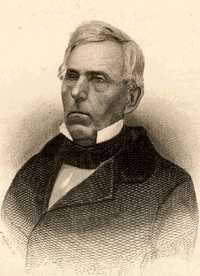Tolbert Fanning
| Tolbert Fanning | |
|---|---|
 Tolbert Fanning | |
| Born |
May 10, 1810 Cannon County, Tennessee |
| Died |
May 3, 1874 (aged 63) Nashville, Tennessee |
| Occupation | Restoration Movement preacher, writer, educator |
| Spouse(s) | Charlotte Fall |
Tolbert Fanning (May 10, 1810 – May 3, 1874) was a Restoration Movement preacher and writer born in Cannon County, Tennessee. His conservative theology within that movement, often expressed in the pages of Fanning's publication, the Gospel Advocate, inspired others such as David Lipscomb, leading to the 1906 identification of the Church of Christ as a distinct religious body, 33 years after Fanning's death.
Biography
Early life
As a boy Fanning lived on the plantations of Alabama and moved to Nashville, Tennessee to attend the former University of Nashville.
Contributions to the Restoration Movement
Fanning is said to have converted under the influence of preachers Ephraim D. Moore and James E. Matthews. He was baptised a member of the church in response to a sermon preached by Matthews seven miles north of Florence, Alabama, around October 1, 1827.[1]
Fanning soon after his arrival in Nashville became one of the recognized leaders of the Restoration Movement, an attempt to purge the Christian religion of its many denominations and restore it to the original doctrines and practices of the church in the 1st century.
Fanning founded a girls' school in Franklin, Tennessee in 1837, the year of his graduation from Nashville University. He founded Franklin College in 1840, notable alumni of which include David Lipscomb, T. B. Larimore, E. G. Sewell, E. W. Carmack, J. E. Scobey, Samuel R. Lowery. and William Lipscomb. He was president of the college until 1861.[2]
Legacy
Fanning's major legacy within the Restoration Movement lay with his advocacy of education. He was an important mentor to David Lipscomb and thought by many to be the source of many his protégé's more pacifist views. (citation needed) Lipscomb University has a dormitory named in honor of him.
Following the American Civil War, Fanning was instrumental in resisting the missionary societies and the use of instrumental music, issues which would eventually lead to the schism, recognized by the U.S. Census in 1906, in which the Church of Christ was first recognized as a separate body from the more liberal Disciples of Christ.[3]
Books
- "The True Method of Searching the Scriptures" by Tolbert Fanning. 67 pages. Cobb Publishing, McLoud, Oklahoma, 2016 [4]
- The Hazard of the Die: Tolbert Fanning and the Restoration Movement by James R. Wilburn. 288 pages with index. Sweet Publishing Company, Austin, Texas, 1969
- Tolbert Fanning vs. Robert Richardson: battling for the birthrights of the "People of the Book" by Darren Ross Johnson. 1999.
References
- ↑ Three Biographical Sketches of Tolbert Fanning at RestorationMovement.com
- ↑ PioneerPreachers.com
- ↑ Earle West, "Search for the Ancient Order," Volume 3
- ↑ http://www.TheCobbSix.com/jimmie-beller-memorial-elibrary/
| Preceded by none |
Editor of the Gospel Advocate 1855–1866? With: William Lipscomb 1855–1861 |
Succeeded by David Lipscomb |
External links
- Works by or about Tolbert Fanning at Internet Archive
- Tolbert Fanning page at the Restoration Movement pages of the Memorial University of Newfoundland
- Tolbert Fanning by A. R. Holton, Restoration Quarterly 1:1 Nashville, Tennessee: Abilene Christian University, 1957.